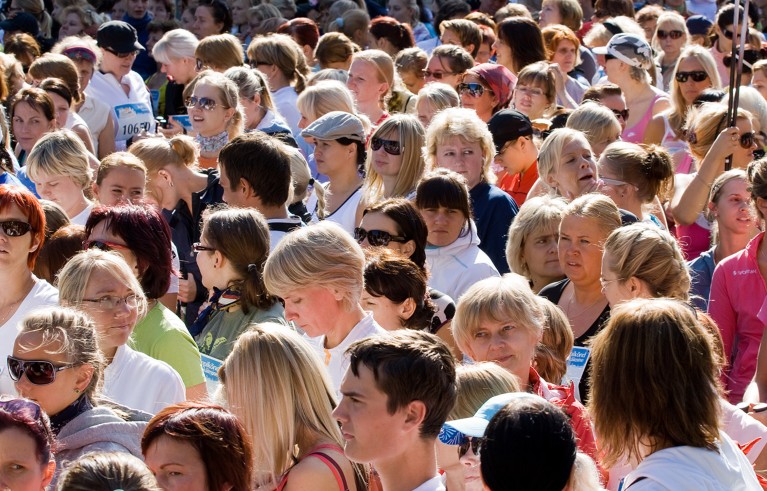
One-fifth of Estonians now have access to information about genetic variants that could increase their chances of certain illnesses.Credit: Ints Vikmanis/Shutterstock
While much of Europe is obsessing over this year’s European Football Championships, many Estonians — whose team didn’t qualify — are absorbed in their own genomes.
This month, the 210,000 Estonians who have contributed samples to the country’s biobank — around 20% of the adult population — were given the opportunity to learn about some of their genetic traits, including disease risk, ancestry markers and how they handle caffeine.
World’s biggest set of human genome sequences opens to scientists
So many people flocked to the online portal that parts of it crashed soon after it launched. “Genetic literacy in the Estonian population is maybe higher than elsewhere,” says Lili Milani, head of the Estonian Biobank and a pharmacogenomicist at the University of Tartu. “The interest is really high.”
The project is one of the world’s biggest efforts to return genetic results to research participants — most biobanks do not provide such information. One reason for sharing the results, say scientists, is to recognize the value that participants contribute. “People have donated their data for this research, and they want something back,” says Andrea Ganna, a statistical geneticist at the University of Helsinki. “It’s a no-brainer. We need to do it and participants want it.”
Returning results
The Estonian Biobank was created by a 2000 law that mandated that the database would allow participants to access their genetic data. But informing so many people about their genomes is easier said than done.
At first, specialists individually counselled participants with a high genetic risk of certain conditions, including breast cancer and cardiovascular disease, or with rare gene variants that affect how they metabolize drugs. But these ‘recall studies’ reached only 5,000 participants, says Milani. “We cannot do face-to-face consultations for 200,000 people.”
The biobank’s online portal provides more limited insights, but the emphasis is still on data that participants can use to improve their health. As well as information about cardiovascular disease and type 2 diabetes based on factors including hundreds of thousands of DNA variants, Estonians receive advice about how losing weight and making other lifestyle changes can cut disease risk. “We know genetic risk alone doesn’t tell you much. You need to put this in the context of your lifestyle,” says Milani.
Australian biobank repatriates hundreds of ‘legacy’ Indigenous blood samples
The portal also informs participants about genetic influences on how their body handles medicines, such as certain blood thinners, and other substances. Milani’s own results show she carries a gene variant that slows the breakdown of caffeine, amplifying its effects. “I had one coffee yesterday and couldn’t sleep. It’s been a bit hectic with the launch of the portal,” she says.
More than 75,000 biobank participants have already visited the website, showing that interest is high, says Milani. (A measure of Neanderthal ancestry that the biobank provides has been trending on Estonian social media.) To measure the effects of receiving health-related information, Milani and her colleagues plan to compare the future health of participants who log into the portal with that of those who don’t.
“The hope, anticipation and expectation is that this should improve people’s health care,” says Dan Roden, a cardiologist and clinical pharmacologist working on personalized medicine at Vanderbilt University in Nashville, Tennessee.
Genetic counselling
The Estonian Biobank data release is part of a growing trend among population health studies. The US-government-funded All of Us study — which aims to collect genome and health data from more than one million people from diverse backgrounds — has communicated genetic results to more than 100,000 participants, with the goal to give all participants the opportunity to receive this information eventually.
The study examines a set of 59 genes for genetic variations linked to diseases that can be treated or prevented. The 3% of participants who carry any of these mutations receive genetic counselling to learn about the results, says Heidi Rehm, a clinical genomicist at Massachusetts General Hospital in Boston who is part of All of Us.
An inside look at the first pig biobank
“If we’ve got their genomes and there’s really critical information in there, particularly that our researchers may study, it seems unfair not to also let them have it,” she adds. Participants who don’t have any of these mutations can see the results online and can still request a meeting with a genetic counsellor.
To be able to show results to participants, All of Us had to jump through several hoops — including operating under a regulatory protocol with the US Food and Drug Administration, which regulates genetic testing. The Estonian programme, Milani says, went through two years of back-and-forth communication with an ethics review board.
Another challenge is funding, says Ganna. Tasks such as contacting participants by post could cost hundreds of thousands of euros.
Returning genetic results is an ongoing process, says Roden. As scientists’ understanding of the links between genetics and health changes, so should the information participants receive. “You’re never at the end of this voyage,” Roden says. “I admire the Estonians, and I think it is a wonderful experiment, a wonderful way of moving genome science forward.”
 World’s biggest set of human genome sequences opens to scientists
World’s biggest set of human genome sequences opens to scientists
 Australian biobank repatriates hundreds of ‘legacy’ Indigenous blood samples
Australian biobank repatriates hundreds of ‘legacy’ Indigenous blood samples
 UK Biobank shares the promise of big data
UK Biobank shares the promise of big data
 An inside look at the first pig biobank
An inside look at the first pig biobank
 Massive Google-funded COVID database will track variants and immunity
Massive Google-funded COVID database will track variants and immunity








